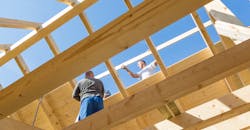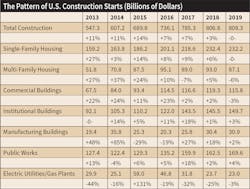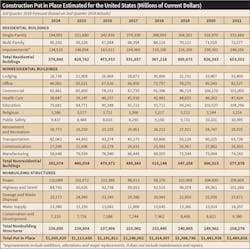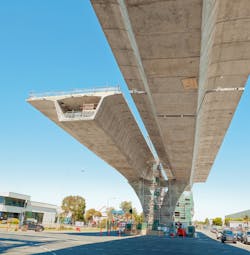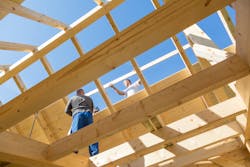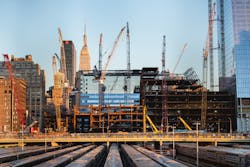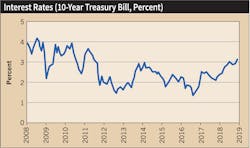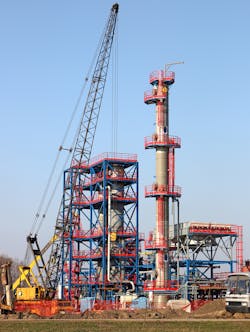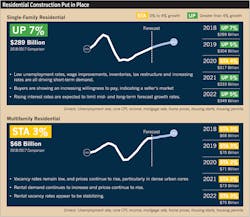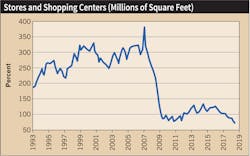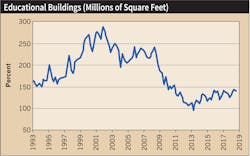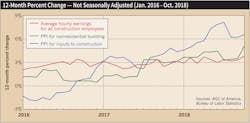Steady as She Goes — For Now: EC&M's 2019 Electroforecast
It’s a busy and heady time of year for economists who weigh in with forecasts for the future. Obligatory, yes, but their crystal-ball work is nonetheless eagerly anticipated in many quarters, few more so than the construction sector that often finds itself at the tip of the spear when whiffs of economic change are in the air.
Now could be one of those times. Multiple, potentially powerful economic and political cross currents are at work as 2019 approaches. An inflection point that could impact architectural design firms, general contractors, electrical designers, and electrical contractors/other subs might be at hand. After an extended period of growth from the depths of the 2008 financial crisis and deep recession, some sort of cyclical slowdown — or possibly mild recession — could be looming.
But there are also new wild cards in the mix — some that haven’t been dealt for years — ones like tariff volatility that could portend yet another punishing recession on one extreme, or the dawn of a new period of extended, super-charged growth on the other. Crystal-ball construction economists trying to sort it all out as 2018 closes, it seems, will be earning their pay.
But those who keep regular tabs on the U.S. construction economy and issue closely watched forecasts aren’t going out on any kind of limb as they look ahead to the new year. As consequential as some of the forces building in the economy could prove to be, organizations like Dodge Data & Analytics, The Associated General Contractors of America (AGC), and the American Institute of Architects (AIA) don’t see them coalescing to deliver a dramatically changed 2019 on the construction front. More likely, they concur, is a year of what might be characterized as a reprieve — staying an arm’s length from any severe impact that cycles, politics, economics, and the simple odds inevitably exert on construction trends. Beyond 2019, though, things could get dicier.
Flat to comparatively modest overall growth, construction watchers say, is probably in the cards for the industry over the course of the next year. Levels of both starts and construction-put-in-place, the measure of spending as projects progress, should vary as usual from sector to sector, some notably (see Table 1 and Table 2). Averaged out, though, they should produce a year that either mildly pads a string of multiple years of growth or doesn’t appreciably dent it. None see anything resembling a downturn on the near horizon, confident prevailing tailwinds from a strong and still-growing economy will keep construction activity humming in the face of some other signals flashing yellow.
“Overall starts look flat, but at the moment that’s probably a conservative estimate,” says Robert Murray, chief economist/vice president at Dodge, and lead author of the widely followed annual Dodge Construction Outlook. “The saving grace standing in the way of any decline is that we’re not seeing any of the imbalances (in key individual sector performance) that have been present in previous expansions.”
Seeing a Pattern
Issued in October, the Dodge report sees U.S. construction starts totaling $808 billion next year, good for a whisker’s growth over Dodge’s projected total for 2018 of $807 billion.
More significant, though, is that such a flattening, essentially, would further confirm a pattern of growth deceleration that began in 2016 with a halving of growth from 2015 and another possible halving in the cards for 2018 from last year. Slowing growth, Dodge says, is typical of maturing expansions and sometimes a hallmark of impending peaks. And the presence of other uncertainties in the economy means 2019 could be shaping up as a pivotal year.
“An important question is whether deceleration is followed by a period of high-level stability or a period of decline,” Murray wrote in an outlook summary.
While Dodge sees no appreciable pickup in starts in 2019, another forecaster has been much more bullish. As late as August, ConstructConnect was seeing 7.8% growth in starts for 2019. But the gap between its forecast and Dodge’s is tempered by ConstructConnect’s lower prediction for 2018 starts. As of August, it saw a slight 0.2% decline in 2018 starts, compared to Dodge’s 3% bump. In February, ConstructConnect was standing by the prediction that between 2019 and 2022 starts would average 5% year-over-year growth.
ConstructConnect continued to project optimism into early November but was a bit more reticent given fresher economic data. Alex Carrick, the firm’s chief economist, said in an AIA-sponsored design and construction outlook webinar that economic uncertainties were building.
“You can be very comfortable with how the economy is doing right now,” but “there are, however, shadows at the edges,” Carrick cautioned, citing rising interest rates and emerging tariff disputes as growth-barrier worries that have escalated since earlier in the year.
There’s more consensus on the outlook for the other important measure of construction activity: construction-put-in-place. Forecasters generally see another year of solid growth in total 2019 spending on construction projects that are either initiated in the year or are carried over from prior-year starts. Such spending may be the more crucial figure for contractors trying to gauge their short-term prospects, while starts may be a better leading indicator — a macro bellwether of where the construction economy is heading.
AIA’s annual Consensus Construction Forecast, updated in August, sees 2019 spending on nonresidential buildings growing 4% in 2019. Spending growth for 2018, earlier pegged at 4%, was revised to 4.7%. Spending forecasts made by a panel of seven firms that follow construction trends, which combine to form the consensus, ranged from a high of 6.3% to a low of 2.8%.
Those positive numbers still look reliable, Kermit Baker, AIA’s chief economist, said in the webinar. But another indicator he watches, AIA’s monthly architectural billings index survey that gauges activity at construction project design firms, could serve as a counterweight; its plunge over two months in 2008 telegraphed the start of a long construction recession.
“That index began moving up (most recently) in early 2017 and stayed strong in 2018 but has weakened a bit in the last two months,” he says. “Design contract work is healthy, but it may be moderating.”
Factoring that recent index reading into the mix, Baker says the worse-case scenario is “there are no signs of anything other than a modest slowdown (in construction spending) moving into 2019. There’s a consensus, though, that the market will be healthy and growing.”
Contractor interests see construction spending growth moderating some in 2019. AGC Chief Economist Ken Simonson sees 2% to 5% growth in nonresidential spending, following 4% to 5% this year. In the residential sector, spending should grow 5% to 9% next year, in line with this year’s estimate of 5% to 7%. But that’s half of the 12% growth seen in 2017.
In the webinar, Simonson said: “So far this year everything but manufacturing construction has been in the plus column, and I think that’s where we’ll wind up the year. Next year, more of the sectors will be fading back toward zero, but I still think everything will remain positive.”
The Economic Backdrop
Predictions of another year of solid construction spending are predicated largely on the continued strength of the U.S. economy. GDP continues to grow, and at a faster rate; unemployment is at a historic low; consumers are confident and spending money; banks are lending; government spending is poised to rise; and corporate profits are strong.
All of that is feeding optimism and helping to sustain/expand private and public sector interest in making more capital investments, including those in buildings, structures, and other physical assets.
“Next year is shaping up to be a pretty good year for the economy, and it’s not until 2020 or 2021 when there to look to be areas of real vulnerability for the economy,” Baker says. “Next summer, if there’s no recession between now and then, we’ll have been in the longest economic expansion in post-war history. Expansions don’t die just of old age.”
The Dodge outlook references the strong economy, noting a pickup in annualized GDP growth in 2018’s second quarter to 4.2%, alongside a 3.8% bump in consumer spending and an 8.7% lift in nonresidential fixed investment. That’s likely to moderate, though, leading to 3% GDP growth this year and a still-strong 2.5% in 2019, the report stated.
That rate of growth should support another leg up in construction spending in 2019, but the year also could see a planting of seeds for the eventual economic and construction activity slowdown that many economists predict. There’s a full menu of rising risks to continued growth in both: higher interest rates (see Fig. 1); creeping inflation; receding impact from 2017 tax cuts; a more volatile stock market; growing labor costs; and accelerating trade wars fed by the possibility of tariffs rising to generational highs that could choke off supply and demand for raw materials and consumer goods. Should these trends take root, the impact could become evident as early as next year. Given the typical lag in cause and effect, however, a more likely scenario would be a hit to growth in 2020 or later.
That could come in the form of slower but still positive growth or a recession of some magnitude. The latter is getting to be longer overdue and even probable, many economists say, but it’s far from a short-term certainty. Less likely, but more feared, is the kind of punishing recession that took root in 2008.
“That was six quarters long and caused a 35% drop in nonresidential construction and a 75% falloff in new housing construction,” Baker says. “The typical recession is two or three quarters where we may see an aggregate decline of a couple of points in growth and a healthy recovery once imbalances are corrected.”
But there are few big imbalances now in the construction economy, and that translates to 2019 forecasts showing individual construction sectors not straying too far from recent performance. While there are subsectors within the main areas of residential, nonresidential building and nonbuilding that could diverge, economists single out few for big, meaningful swings. Trends, however, are defined by small initial moves, and forecasters say they bear watching in 2019.
Residential Divergence
The residential construction sector might be a prime example. Single-family and multi-family construction (combined) should show some continued growth next year, but their individual performance will likely differ, forecasters say.
Dodge, for instance, sees the dollar value of single-family construction starts hugging that of 2018, around $232 billion, with units and square footage down around 3%. Multi-family construction, though, is seen declining 6% in dollars to $87 billion and around 8% in space added. Added up, that means the value of total residential construction starts might decline 2% next year to $319 billion.
“A big difference in this construction cycle versus the last one is that multi-family has been on the leading edge, whereas single-family was previously,” Murray says.
Multi-family, he says, may now be overbuilt, while single-family construction may have more room to run. Both, however, are highly sensitive to interest rates, and their steady rise over the past few years and uncertain path forward could inject more volatility into the sector. On track for a 4% gain this year, total housing starts could decline 5% next year, Dodge predicts. Long-term, though, steady economic growth should result in more household formation and housing stock will likely have to increase.
FMI Corporation’s most recent construction outlook for the 2018 third quarter also sees multi-family and single-family heading in different directions, short-term. It sees single-family construction put-in-place heading up 5% to $304 billion in 2019 and multi-family staying about even with 2018’s projected number of $68 billion (see Fig. 2).
“Multi-family numbers are a cautionary flag for residential construction, but we feel good about the amount of need in the single-family space to keep the sector going for a while longer,” says Brian Strawberry, senior economist with FMI Corp., Raleigh, N.C. “It appears the large urban core market is overbuilt in multi-family, and that the single-family rebound is nowhere near where we were in 2006.”
AGC sees new single-family construction spending rising in the 5% to 9% range next year, after 5% to 7% this year. Multi-family will pick up a bit after two years of stagnation, to between 2% to 5%.
“Single-family starts will slow because of rising prices,” Simonson says. “Multi-family may be overbuilt some but with less interest in single-family because of rates it should start to grow again.”
Nonresidential Questions
Forecasts for 2019 activity in nonresidential construction, consisting of many subsectors that react differently to economic forces and are now in various stages in their cycles, are in a tight range, some showing growth, some a decline. But demand for structures of all types has been robust for the last several years, and the slow and steady economic recovery combined with historically low interest rates has taken some of the gamble out of development bets. With the economic backdrop changing, though, more volatility in starts and spending might be emerging.
Dodge checks in with a forecast of zero growth in the value of nonresidential starts ($296 billion) and a 4% decline in new square-footage; ConstructConnect sees a rebound to spending growth in 2019, rising 5% to $306 billion after a likely 6% decline in 2018; and FMI sees non-residential spending climbing 6.3% to $547 billion.
“I think we’re starting to see a transition in construction cycles to where we’ll be heavy in private commercial, nonresidential investment for the next year or two, through maybe early 2020,” says Strawberry.
Simonson, whose AGC forecast has nonresidential growing some next year, says that sector has fought off declines and may be poised for another run.
“In 2017 there was actually a small 0.5% decline in public and private spending on nonresidential projects,” he says. “Through the first nine months of this year, we see a 5% increase over 2017. So, that’s quite a strong rebound, and I think we’ll finish the year in that same range.”
But sectors within nonresidential construction are almost sure to march to their own tunes in 2019, and forecasts vary.
Commercial project activity, highly sensitive to economic conditions, is due for a downturn, according to Dodge. Starts in projects that exclude manufacturing, education, health care and other institutional, are likely to decline 7% in square footage and 3% in contract value, to $116 billion. But by roughly the same measure, FMI sees commercial spending tacking on 7% in 2019, to $281 billion. AGC sees commercial spending being flat on the low end, to around 5% on the high end.
Dodge, Murray says, sees commercial starts being dampened by an overhang of capacity added earlier, continued erosion of demand for brick-and-mortar retail space, possibly higher vacancy rates for offices and warehouses and slack demand for new lodging projects (see Fig. 3).
“The pickup in office and hotel construction has been moderate, but warehouses is one that has come close to reaching earlier peaks,” Murray says. “The fact that it’s been a measured expansion for commercial building means the imbalances are not there as in prior cyclical upturns.”
AIA sees commercial, along with industrial, spending growth lagging that of other areas next year. Its consensus is for commercial spending slowing from 6.7% to 3.4% growth, but a pickup in industrial from flat in 2018 to 5% in 2019.
“It will be a fair amount slower on the C&I side, but industrial is moving in the other direction,” Baker says. “What’s going on there partly is a huge increase of interest in petrochemical facilities, which are big projects with a long spend time.”
Murray also cites petrochemical project growth as a driver for manufacturing starts, which could tack on a bit more spending growth following a likely 18% surge this year. Other energy-related projects, such as transmission and distribution, might be harder to call. FMI sees power project spending up by around 3%, while Dodge sees a 3% decline in electric utilities starts.
Institutional projects could be the big driver for nonresidential activity in 2019. Private and public spending on health care, educational, and public safety facilities could pick up and take up the slack in spending growth that could materialize elsewhere. Growing demand for new resources in those areas has produced funding streams that could drive starts and propel ongoing spending.
Dodge sees institutional starts with a value of almost $150 billion next year — a 3% rise — led by educational and health care, each up by 6%. FMI sees institutional spending rising by around 6%, while the AIA consensus is for around 4.5% (see Fig. 4).
“Health care and education are similar to infrastructure in terms of needs, and there are also more prison projects in the pipeline, “says Strawberry. “As long as there is population growth and shifts in population there will be demand for these types of projects.”
Institutional projects, Murray says, could shoulder a lot of responsibility for keeping construction spending growth moving ahead.
“An important point for 2019 is that the public financing side of the construction industry should maintain an enhanced level of activity achieved in 2017 and 2018,” he says.
That trend is also likely to impact spending on non-building public works projects. Dodge sees transportation- and environment-related starts moving ahead at a brisk 4% next year, to $170 billion — similar to forecasts of others. It’s thought that Congressional passage of a small-scale infrastructure spending package will keep projects moving, as could approval of the ballyhooed comprehensive infrastructure upgrade plan.
Heading into 2019, it’s an open question whether the nation’s physical infrastructure — writ large — is at present too big or not big enough. That calculation is getting harder to make as both broad economic and construction sector upward growth trends edge into territory that may be hostile to their survival. The odds may eventually catch up with both, and rising uncertainties about the path forward raise those prospects. The good news, though, may be that growth has been slow and steady, and the word “excess” isn’t part of the current economic vocabulary.
“Barring something like a severe financial sector downturn, any pullback for construction, when it comes, will probably be comparatively mild and in no way a replay of what happened in 2009 and 2010,” Murray says.
Zind is a freelance writer based in Lees Summit, Mo. He can be reached at [email protected].
Sidebar: Material Costs are Rising Faster than Bid Prices
An emerging subplot in the story about construction growth trends is the prospect of higher costs to deliver projects.
Economists assessing construction prospects for 2019 and beyond say the cost of labor and materials for contractors bears watching. They’ve been on the rise, they note, and at some point they could begin to take some of the air out of the industry’s sails.
Labor is a growing concern because historically low levels of unemployment have made it harder to find construction workers in a period of growth. That translates to positions left open or filling them with less skilled workers who nonetheless cost more. On the materials side, rising demand and the possibility of higher import tariffs could push up prices of an array of building products.
Up to a point, higher costs may be manageable for contractors. But when bids begin to reflect them, and project costs rise, calculations could change.
“Higher costs could eat into demand for construction work,” says Ken Simonson, chief economist at The Associated General Contractors of America (AGC). “Owners could say projects no longer pencil out or start to ask where costs could be reduced through redesigns, labor reductions, or more offsite production.”
AGC’s recent workforce survey of members found 62% saying they’re having to raise pay to attract workers. And almost half said the labor challenge is translating to higher costs, higher bid prices, and longer project completion times. AGC also cites U.S. Bureau of Labor Statistics data showing prices rose on six of eight key construction inputs for the year ended October 2018. Increases ranged from 3% to 27%. Steel mill products, which rose 18%, could be in for more hikes if the United States slaps more tariffs on imported steel (see Figure).
“It could be a challenging year for the industry in terms of coping with sudden price shocks,” he says.
Robert Murray, the Dodge Data & Analytics chief economist who prepared a 2019 construction outlook, is more sanguine about the impact of higher labor and materials costs. There’s scant evidence projects are being cancelled or delayed, but they could lead to modifications, he says.
“They could have some dampening effect on construction activity, but that is still going to be shaped mostly by market fundamentals,” he says.
About the Author
Tom Zind
Freelance Writer
Zind is a freelance writer based in Lee’s Summit, Mo. He can be reached at [email protected].
